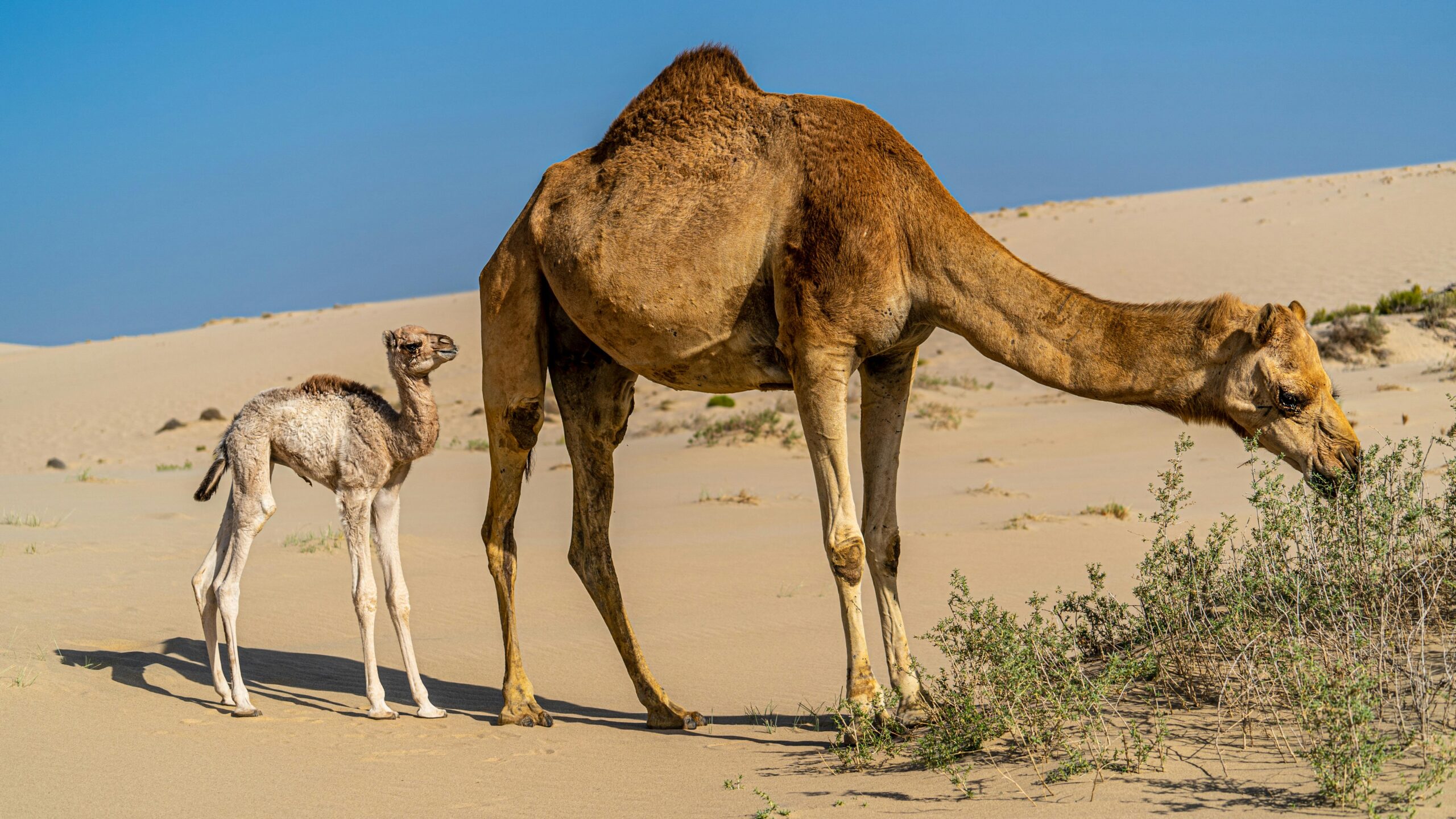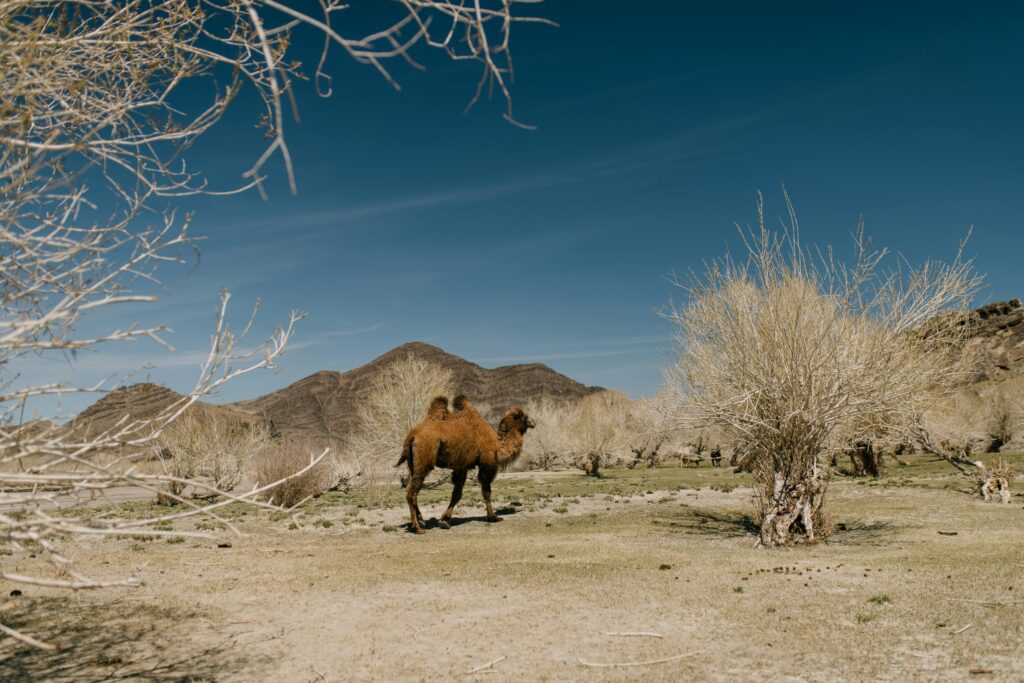In the vast and unforgiving landscapes of the arid deserts, few creatures are as synonymous with resilience and adaptability as the camel. These incredible creatures have evolved over millennia to thrive in some of the harshest environments on Earth. From their distinctive humps to their unique behaviors, camels showcase an array of fascinating adaptations that make them perfectly suited for desert life.
Water Storage and Conservation
One of the camel’s most renowned adaptations is its ability to survive for long periods without water. Camels exhibit behavioral adaptations that aid in water conservation. They are known for their ability to regulate body temperature by varying their activity levels throughout the day, often resting during the hottest hours to reduce water loss through sweating.
Camels also have a unique ability to tolerate dehydration, allowing them to go for days without drinking water by relying on the fat stored in their humps as an energy source. A thirsty camel can drink an impressive amount of water in a single day, often ranging from 25 to 40 gallons (95 to 150 liters). This extraordinary capacity allows camels to replenish their water reserves and endure long periods without drinking in the harsh desert environment.
Additionally, their kidneys are highly efficient at conserving water, producing concentrated urine, and minimizing water loss.
Versatile Diet
In the unforgiving deserts where lush greenery is a rarity, camels stand out as nature’s true survivors, thanks in large part to their versatile diet. From prickly cacti to spiny shrubs, camels have mastered the art of survival by making the most of what their environment has to offer.
Camels are renowned for their ability to consume thorny desert plants and coarse vegetation that would leave most other herbivores searching for greener pastures. What sets them apart is their remarkable digestive system, which includes a multi-chambered stomach designed to efficiently ferment their food. This unique adaptation allows camels to extract maximum nutrients from even the most sparse and tough desert foliage, ensuring their sustenance in harsh environments where food is scarce.
Adding to their dietary prowess, camels boast large, durable lips that are specially adapted for foraging in arid landscapes. These lips are adept at navigating through dry, thorny vegetation without sustaining injury, allowing camels to access food sources that would be off-limits to many other animals.

Thermal Regulation
Camels possess unique adaptations that enable them to regulate their body temperature effectively. Through a combination of physiological, behavioral, and anatomical adaptations, camels have become masters of thermal regulation.
One of the most striking features is their ability to conserve water, which plays a crucial role in temperature control. Unlike many other mammals, camels can go for extended periods without drinking water, thanks to their highly efficient kidneys that reabsorb water from urine, producing concentrated urine and minimizing water loss.
Camels exhibit behavioral adaptations to avoid overheating. They are known for their ability to adjust their activity levels throughout the day, often resting during the hottest hours to conserve energy and reduce water loss through sweating. By minimizing physical exertion during peak temperatures, camels can maintain a more stable body temperature.
Another key aspect of camel thermal regulation is their unique anatomical features. Camels have a thick coat of fur that serves as insulation against the intense desert sun, helping to prevent overheating. Additionally, their nostrils are specially designed to close tightly, preventing sand and dust from entering the respiratory system and reducing moisture loss during breathing.
Specialized Feet
In the arid environments where camels roam, their feet are equipped with remarkable adaptations to navigate the scorching sands. These creatures boast broad, flat pads that are not only leathery but also highly resistant to heat. This unique design serves a crucial purpose: when they trek across the desert terrain, these pads spread out, effectively preventing the animals from sinking into the blistering hot sand.
These heat-resistant pads aren’t confined to just their feet. They’re also strategically placed on their knees, sternum, and elbows. Why? To provide protection and prevent burns when these resilient creatures lie down in the blazing sun. Additionally, these pads facilitate air circulation beneath their bodies, aiding in their quest to stay cool amid the desert heat.
Respiratory Adaptations
In the harsh desert environment, camels have perfected the art of breathing to survive. Their respiratory system is finely tuned to combat the challenges of sandstorms and arid conditions. Camels have specially adapted nostrils that can be sealed shut, preventing abrasive sand from infiltrating their airways during storms.
Camels also possess a remarkable ability to regulate their breathing, allowing them to conserve precious moisture. Through their nasal passages, they can reabsorb water vapor from their exhalations, a crucial adaptation for staying hydrated in the desert.
Dromedaries, in particular, have nostrils designed to shut tight, shielding them from the abrasive onslaught of sand. Additionally, their distinctive bushy eyebrows and long eyelashes serve as natural barriers, safeguarding their sensitive eyes from the harsh elements. 
Fat Storage and Energy Efficiency
Camels have evolved to store large quantities of fat within their humps, which act as energy reserves during times of scarcity. When food is scarce in the harsh desert landscape, camels tap into these fat stores, metabolizing them to fuel their bodies. This unique adaptation allows camels to sustain themselves over long distances without the need for frequent meals—a crucial advantage in their quest for survival.
What makes this fat storage system particularly remarkable is its energy efficiency. Fats are dense sources of energy, providing more than twice the amount of energy per gram compared to carbohydrates or proteins. By efficiently metabolizing stored fats, camels can sustain their energy levels for extended periods, enabling them to endure the challenges of their arid habitat.
Eye Protection Adaptation
In arid environments where sand and debris are commonplace, camels need effective eye protection. While their long lashes and bushy brows do provide some defense, nature has equipped them with an additional feature: a third eyelid, scientifically known as the nictitating membrane. This thin, translucent layer acts like a windshield wiper, sweeping away any pesky particles that manage to breach the outer defenses.
Appreciating Nature’s Ingenious Survivor
The camel stands as a testament to nature’s ability to adapt and thrive in challenging environments. Its remarkable suite of adaptations—ranging from physiological features to behavioral strategies—underscores the ingenuity of evolution. As we continue to explore and understand Earth’s diverse ecosystems, the camel serves as a compelling example of how living organisms can conquer seemingly insurmountable challenges through adaptation.

will these adaptations of the camel make it difficult for it to survive in a cold and wet climate?